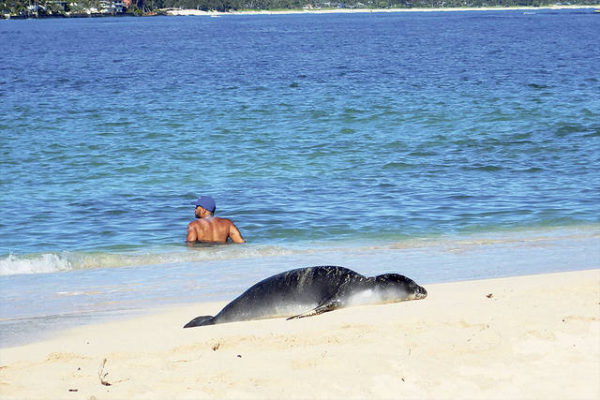Published in the Ocean Watch column, Honolulu Star-Advertiser © Susan Scott
October 20, 2018
QUEENSLAND, Australia >> Craig and I are back aboard our 37-foot ketch, Honu, in Townsville’s charming Breakwater Marina. We plan to sail to some new places in the Great Barrier Reef Marine Park, a thrilling prospect. But as we shop for groceries, get gas for the outboard and do all the other chores necessary to set sail, I’m still aglow over a marine animal thrill I had in Hawaii the day before we left.
Craig and our Kailua friends had decided to paddle their stand-ups to the Mokulua Islands off Lanikai and invited me to join them in my kayak. Even though we were leaving for Australia the next morning, I could not refuse, and off we went in the early morning under a cloudless sky.
 Through the coming and going of swimmers and paddlers,
Through the coming and going of swimmers and paddlers,
this monk seal sleeps peacefully on Moku Nui’s beach.
©2018 Susan Scott
We paddled toward the twin islands, both seabird sanctuaries affectionately known as the Mokes, in clear, flat water. An hour later we were surfing our little boats through the break and hauling them up the white-sand beach.
Visitors are forbidden on the smaller island, Moku Iki, but the beach of the larger island, Moku Nui, is open to the public. It’s an excellent place for paddlers to watch wedge-tailed shearwaters, booby birds and frigate birds coming and going, and enjoy the eye-popping view of Windward Oahu from offshore. Breeding areas of the ground-nesting birds are roped off with large, artful signs explaining the life story of our native seabirds.
After admiring the colorful signs, we walked back to the beach to explore tide pools. And that’s when a young monk seal popped out of the water and wiggled ashore.
I’ve had some experience working with Hawaii’s monk seals, but watching that animal emerge from the surf, its gray fur coat as smooth and shiny as dolphin skin, gave me chicken skin.
One reason was the seal’s apparent health. The well-nourished animal had not one mark on its fur, unusual in older seals. While mating, male monk seals hang onto females’ backs with their teeth, often leaving wounds that form scars. Sharks too leave their marks. Common on monk seal bodies are scars from the well-named cookie cutter sharks that bite out nearly perfectly round pieces of flesh.
Another remarkable feature of our lovely seal was its indifference to humans milling around the beach it had chosen for a nap. I was equally impressed with people’s reaction to the seal’s sudden appearance. Paddlers silently scooted their vessels back to make space for the animal.
In minutes two workers from the Hawaii Marine Animal Response team arrived on a jet ski. The friendly men allowed eager children to help erect a rope barrier with a sign explaining that this critically endangered species needs to rest. The seal slept through it all.
I’m looking forward to another adventure on the islands and reefs of Australia’s famous marine park. Always on my mind, though, is the fact that I get to come home to islands just as good.